Plunge into the mystery of the number 4 in the Bible, revealing layers of creation, universality, and divine manifestation.
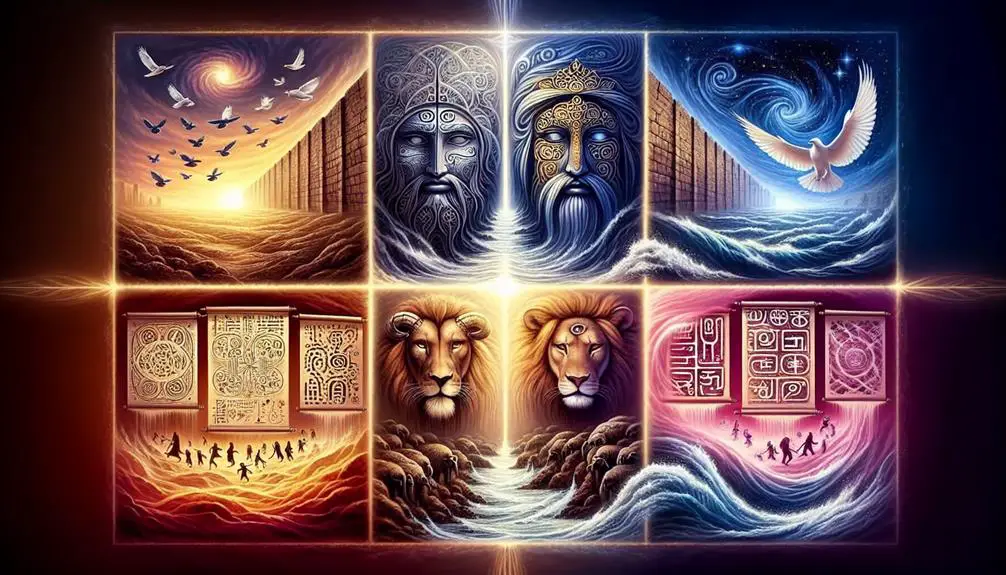
Meaning of the Number 4 in the Bible
Imagine you're exploring the four rivers of Eden, a concept that not only marks the cradle of humanity but also signifies the beginning of life's complexity and diversity according to the Bible.
This number, four, recurs with intriguing regularity, from the four corners of the earth to the four living creatures seen in prophetic visions. The symbolism woven into the fabric of scripture is rich and multifaceted, hinting at creation, universality, and the manifestation of God's power.
Now, you might wonder how these elements tie together and what deeper insights they reveal about the divine narrative. Let's embark on this journey to uncover the layers of meaning behind the number four in biblical texts, and perhaps, in the process, gain a broader understanding of its spiritual significance.
Key Takeaways
- The number 4 symbolizes universal truth and completeness, as seen in the Bible's foundational elements.
- It represents global unity through the "Four Corners of Earth," emphasizing God's sovereign reach.
- The Four Rivers of Eden and Four Living Creatures highlight creation's interconnectedness and God's multifaceted nature.
- The Four Gospels provide unique perspectives on Jesus, underpinning the New Testament's core teachings.
Biblical Symbolism of Four
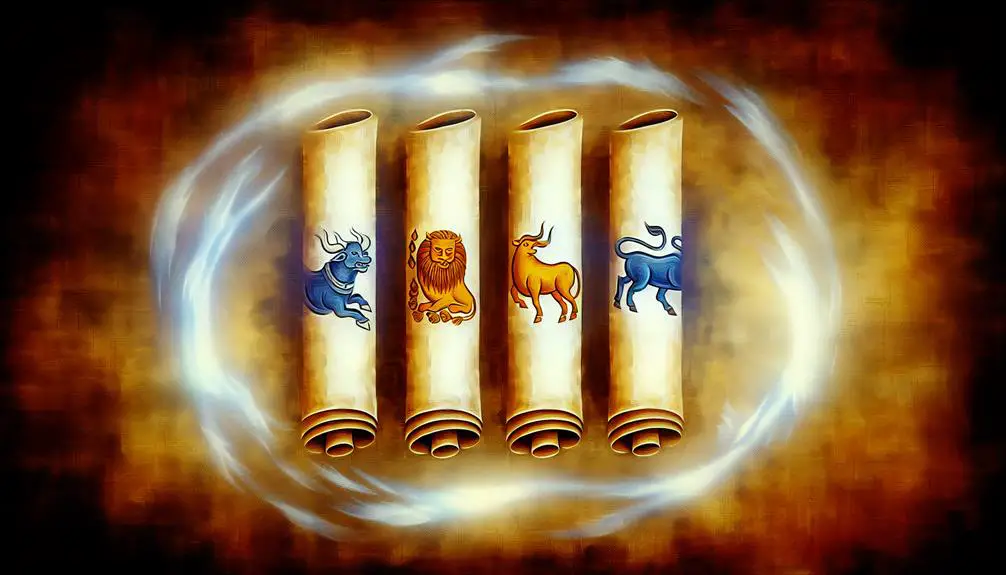
Throughout biblical scripture, the number four is imbued with profound symbolism, often representing universal truth and completeness. This numerical motif, recurrent in various contexts, signifies not just an arbitrary figure but a foundational element within the Creation structure. It's pivotal to grasp that in the realm of biblical analysis, numbers aren't mere placeholders but carry deep theological and cosmological significance.
Delving deeper, you'll find that the number four is intricately linked with the concept of Divine completeness. This association is evident in the depiction of the world's creation, where the fourth day marks the completion of the material universe – the sun, moon, and stars are set in the heavens, delineating time and seasons, thus bringing order to the cosmos. This act of creation embodies the essence of divine order and completeness, a testament to the Creator's sovereignty and the structured nature of creation itself.
Moreover, the number four's symbolic presence underscores the meticulously organized framework upon which life is built. It reflects a divine blueprint, a testament to the Creator's forethought and precision. In essence, the recurrence of the number four within scriptural narratives is a subtle yet profound reminder of the interconnectedness of creation, governed by a divine order that ensures balance and completeness.
Four Corners of Earth
Building on the previous discussion of the number four's significance, consider its application in the concept of the 'four corners of the Earth,' which further illustrates the idea of universal completeness and order in biblical texts. This imagery not only invokes a sense of global unity but also emphasizes the importance of directional symbolism in understanding the world's structure from a biblical perspective. The notion of the Earth having four corners is symbolic, representing the entire globe being encompassed within God's purview, highlighting His sovereignty over all creation.
This concept of the 'four corners of the Earth' serves as a metaphor for the totality and inclusiveness of God's creation, reinforcing the idea that His dominion and influence extend to the extremities of the world. It's a powerful representation of global unity under divine authority, where each corner signifies a direction that, together, covers the entirety of the Earth. This directional symbolism is pivotal, as it underscores the comprehensiveness of God's reach, ensuring that no part of creation is beyond His influence or care. The imagery of the four corners thus becomes a cornerstone in illustrating the biblical theme of universality and divine omnipresence.
Four Rivers of Eden

The narrative of Genesis vividly delineates the existence of four rivers in Eden, which serve as a testament to the divine orchestration of life's beginnings and the interconnectedness of creation. These rivers, flowing from a single source, underscore the unity and abundance of life, symbolizing sustenance, fertility, and the spread of civilization. Each river, with its unique path and destination, contributes to the rich tapestry of Eden's geography, highlighting the intricate design and purpose inherent in the divine plan.
- River Significance: Each river's course and destination are deeply symbolic, representing the flow of life and the spread of humanity's influence and civilization across the earth.
- Eden's Geography: The description of these waterways offers insights into the physical and spiritual landscape of Eden, suggesting a place of immense beauty, fertility, and divine presence.
- Interconnectedness of Creation: The rivers exemplify the interconnectedness and interdependence of all elements within creation, emphasizing the importance of balance and harmony in the sustenance of life.
Analyzing the four rivers of Eden not only enriches our understanding of biblical geography but also offers profound insights into the symbolic and spiritual dimensions of water as a source of life, purification, and renewal.
Four Living Creatures
In biblical symbolism, the four living creatures described in the Book of Revelation and the Book of Ezekiel hold profound significance, representing attributes of God's nature and the embodiment of His creation. These entities are often linked with Cherubim significance, creatures that stand in the presence of the Almighty, suggesting an intimate connection with divine power and wisdom. Each of the four living creatures possesses distinct features—such as the face of a lion, an ox, a human, and an eagle—symbolizing strength, service, intelligence, and sovereignty, respectively. This imagery not only underscores the diversity and completeness of God's creation but also reflects the multifaceted character of God Himself.
The apocalyptic imagery associated with these celestial beings serves a dual purpose. It conveys the majesty and awe-inspiring nature of God's kingdom while also emphasizing the notion of divine surveillance and protection. These creatures, with eyes all around and within, are ever-vigilant, embodying God's omnipresence and omniscience. Through this symbolic representation, you're invited to ponder the complexity and holiness of the divine, encouraging a deeper reverence and understanding of the spiritual realm.
Four Gospels Explained
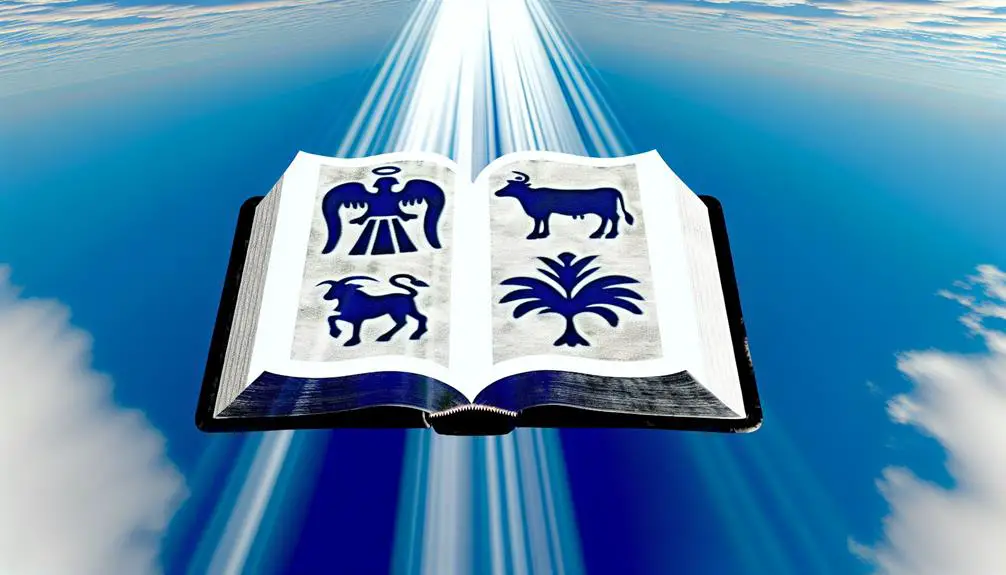
Exploring the four Gospels, you'll find they serve as the cornerstone of the New Testament, each offering a unique perspective on the life, teachings, and significance of Jesus Christ. The Gospel authors—Matthew, Mark, Luke, and John—each bring a distinct narrative and thematic focus that contributes to the comprehensive understanding of Jesus' mission and message.
- Matthew emphasizes Jesus as the fulfillment of Old Testament prophecies, presenting Him as the awaited Messiah for the Jewish people.
- Mark offers the most concise account, highlighting Jesus' actions and miracles, portraying Him as the Servant of God.
- Luke, written by the only Gentile Gospel author, focuses on Jesus' compassion and inclusivity, emphasizing His outreach to the marginalized and Gentiles.
- John stands apart with its theological depth, presenting Jesus as the incarnate Word of God, emphasizing His divine nature and the significance of belief in Him.
This message diversity among the Gospels reflects a multifaceted portrait of Jesus, accommodating a wide audience range. The Gospel authors skillfully weave together a narrative that's both historically rooted and rich in theological implications, ensuring that the message of Jesus Christ resonates across different cultures and historical periods.
Frequently Asked Questions
How Does the Number 4 Relate to the Days of Creation in the Bible?
You'll find that the number 4 doesn't directly correlate with the days of creation in the Bible. However, it holds significant creation symbolism, particularly in representing universality and completeness through the four cardinal directions—north, south, east, and west.
This symbolism extends to the creation narrative by emphasizing the holistic and orderly design of the world, showcasing the foundational structure upon which the earth and its cardinal points were established.
Are There Any Significant Biblical Characters Associated Specifically With the Number 4?
You're diving deep into the symbolism of biblical numbers, exploring the essence of four.
Significantly, the Four Horsemen of the Apocalypse emerge as a pivotal portrayal, encapsulating conquest, war, famine, and death.
Moreover, the Garden of Eden's Four Rivers—Pishon, Gihon, Tigris, and Euphrates—symbolize life's sustenance and the spread of God's blessings.
These examples reflect the profound impact and intricate interplay of the number four in biblical narratives.
How Does the Number 4 Influence the Interpretation of Dreams in Biblical Texts?
In biblical texts, the number 4 often plays a crucial role in interpreting dream symbols, shedding light on deeper meanings. This numerical pattern isn't random; it's deeply rooted in the text's theology and cosmology, influencing how dreams are deciphered.
For example, the recurrence of the number 4 in dreams could symbolize universality or completeness, guiding scholars to a more nuanced understanding. This approach requires a careful analysis of both the dreams and the surrounding narrative.
Are There Any Prophetic Implications of the Number 4 in the Context of End Times as Described in the Bible?
You're diving into a complex topic.
In the context of end times, the number 4 carries significant prophetic weight. Consider the Four Horsemen of the Apocalypse, symbolizing conquest, war, famine, and death; they're central to Revelation's narrative.
Similarly, the prophecy of the Four Kingdoms in Daniel outlines a succession of empires leading to the end times. These elements underscore a pattern of divine order and judgment pivotal to biblical eschatology.
How Has the Number 4 Been Historically Interpreted or Used in Biblical Numerology Outside of the Canonical Texts?
You might think numerology's a stretch, but historically, the number 4 has been richly interpreted beyond biblical texts.
It's linked to the Four Elements—earth, air, fire, water—and the Four Directions—north, south, east, west, grounding its symbolism in creation and stability.
This usage demonstrates how deeply the number 4 is woven into our understanding of the world, providing a scholarly, detailed look at its significance beyond just religious texts.
Conclusion
In the labyrinth of biblical symbolism, the number four stands as a cornerstone, anchoring the divine narrative in the physical realm. It symbolizes completeness, from the earth's four corners to Eden's nourishing rivers.
It also symbolizes the vigilant guardians of prophecy and the four gospels, each a compass point guiding the faithful. This quartet harmonizes the celestial with the terrestrial, painting a comprehensive picture of divine order that beckons believers to find their place within its sacred geometry.

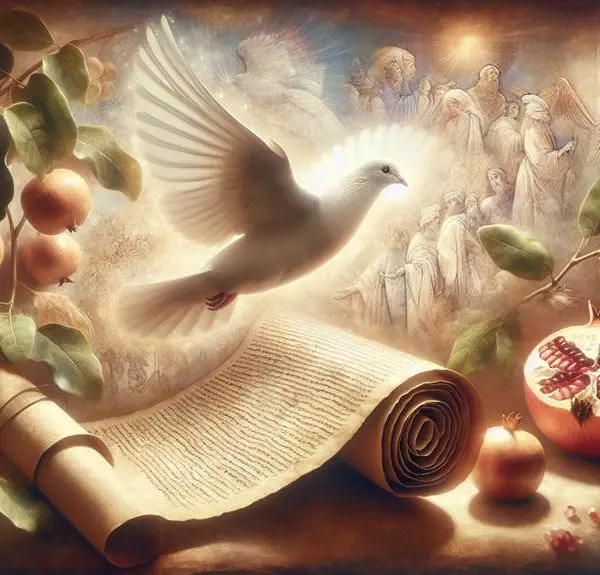
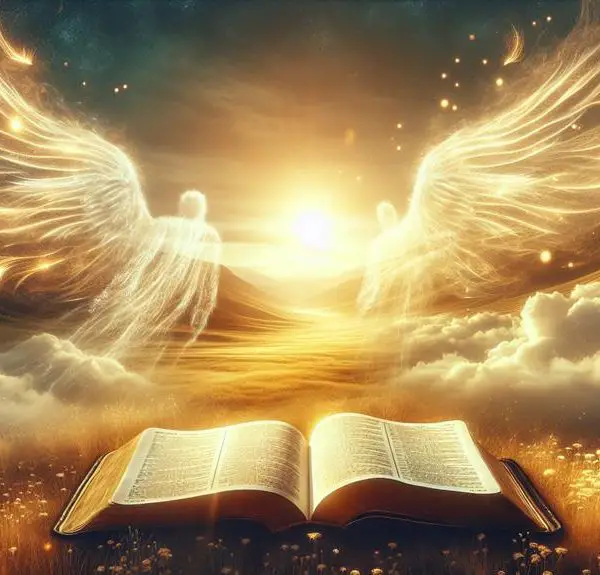
Sign up